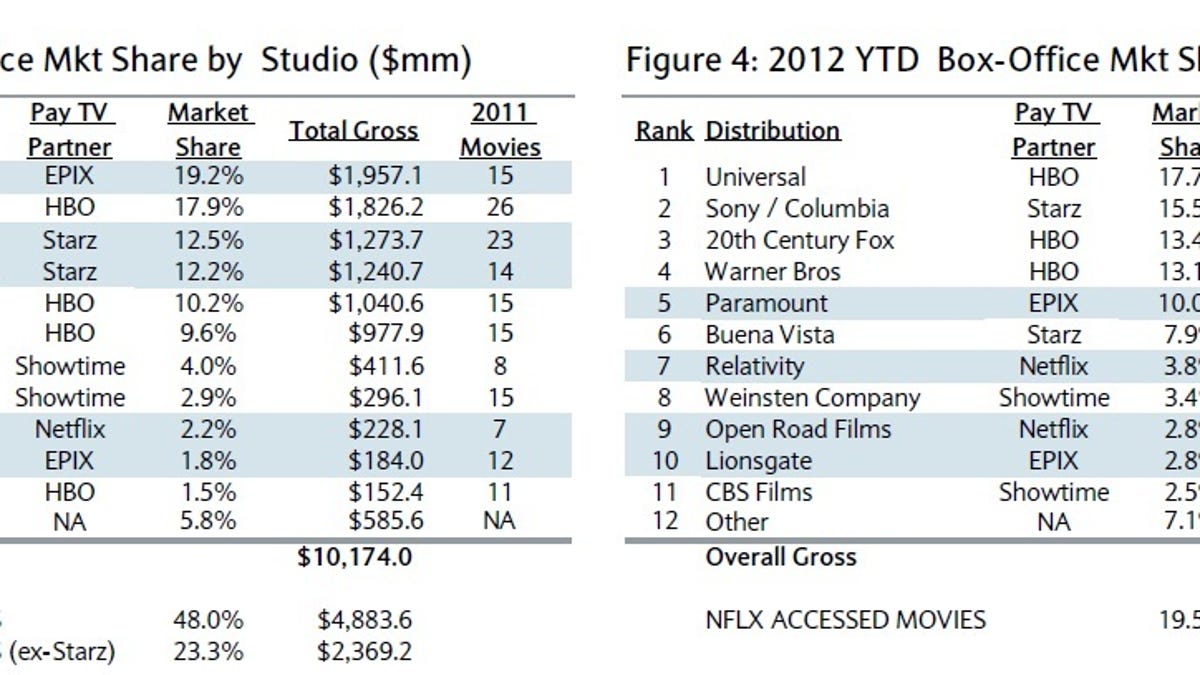Netflix at risk again, Barclays says and downgrades shares
Barclays sees a risk-filled future for video rental company, which faces more competition in U.S. and abroad. And while content costs rise, the quality of Netflix's streaming library declines.
Netflix has appeared to claw its way back from a turbulent 2011, but Barclays is warning of new threats in the company's future.
In a report issued today, Barclays analyst Anthony DiClemente downgraded Netflix's stock to a hold rating. Much of what's giving DiClemente the heebie jeebies about Netflix shares we've heard before: Amazon is adding more and more titles to the company's Prime streaming-video library, the costs of acquiring content are skyrocketing, and there are more competitors in the United States and in overseas markets.
But dig into DiClemente's numbers a little and the headwinds blowing at Netflix, the Web's top video rental service, start to seem tropical-force.
Amazon now has nearly half as many streaming titles (17,000) as Netflix (35,000), according to the analyst. DiClemente estimates that Amazon could be up to 75 percent by the end of the year. Let's not forget that Amazon's Prime service is cheaper than Netflix. Prime is an Amazon membership program that offers customers free two-day shipping and unlimited access to a pool of video for $79 per year. A streaming-only Netflix subscription is $96 per year.
DiClemente also noted the February rollout of Comcast's Streampix Web video service, which he thinks could be the streaming model for other cable companies and limit Netflix's ability to offer content to cable distributors. In addition, DiClemente says that while Streampix is offered only to Comcast now, it could be offered to the general public and compete directly with Netflix.
As for the health of Netflix's streaming library, Barclays didn't just look at the number of available titles. That can be misleading, because it doesn't say anything about whether the selection is attractive to potential renters.
"As of February 29th, Netflix lost access to Starz (the premium pay-TV service) content after negotiations between the two sides fell apart over price," DiClemente wrote. "And now, Netflix only has the output rights to about 20 percent of the box office gross in the year to date, compared to 48 percent in 2011."
DiClemente sets us up with that note about the decline of Netflix's streaming library and then tells us the cost of that content is mushrooming. "In 2010, Netflix's amortization of streaming content costs represented just 12 percent of revenues," DiClemente wrote. "In 2012, we estimate streaming amortization costs will increase to 50 percent of total revenues."
That leaves us with this one big question: how is Netflix going to pay for new streaming movies and TV shows when a lackluster library is bound to attract fewer new subscribers? Without new subscribers, there's less subscription revenue coming in.
And that's one of the main reasons why DiClemente is less enthusiastic about Netflix.
"While a gradual shift to a higher concentration of streaming costs is to be expected, the rapid pace of growth is concerning, especially for a company that is not expected to generate positive free cash flow in 2012 and has cash and investments of $798 million."
With only $800 million to play with, Netflix may not have enough money to fight it out in an arms war for content with the likes of Amazon and Comcast, which have cash balances of $9.6 billion and $1.7 billion, respectively.
If there is any good news in DiClemente's report, it is that he expects Netflix to continue growing in 2012. Netflix said that it expects to add 1.5 million new U.S. subscribers in the first quarter of this year, and DiClemente said he actually expects to see something nearer to 1.75 million. This is consistent with other recent research that predicts the streaming-video market to grow and for Netflix to lead the way.
That said, after 2012, DiClemente's outlook is bleak.
"The old virtuous cycle," DeClemente wrote, "of increasing subscriber growth, higher free cash flow, and subsequent investment in new digital content will be more difficult to replicate in today's more competitive environment."


